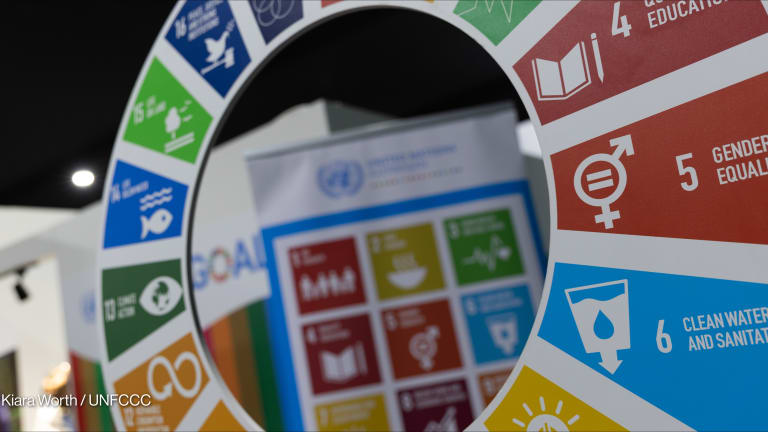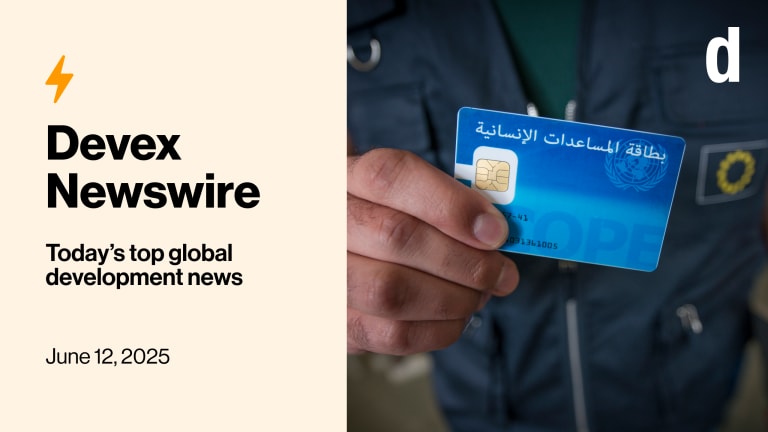Oxfam grapples with taking blockchain beyond pilots
Oxfam Australia has completed testing money transfers from Australia to Vanuatu with blockchain. As the organization looks toward wider applications, its leaders speak with Devex about challenges and opportunities.
CANBERRA — Oxfam Australia has completed testing the use of blockchain technology to transfer money from Australia to Vanuatu, and the use of post-paid cards to spend these funds at select local stores, within two communities. Funded with a grant from the Australian Department of Foreign Affairs and Trade, the aim was to test a cheaper, faster, and more transparent way for people in the Pacific to send cash transfers — particularly after an emergency event. For Sandra Uwantege Hart, Oxfam’s Pacific cash transfer and livelihoods lead in Vanuatu and the blockchain project manager, the results were exciting and confirmed that blockchain could be used to accelerate the cash transfer process. “We were all extremely thrilled to see how smoothly and quickly the trial went,” Hart told Devex. The trial covered two communities, including 187 people and 28 shop vendors over the course of a month. It included training, on-boarding, and a shopping week, during which recipients could use their e-vouchers at local vendors in the community, Hart said. The trial used an app and platform developed by Melbourne-based company Sempo to support the delivery of funds in less than six minutes. This is one of several blockchain trials Oxfam is undertaking to help the aid sector understand the technology’s potential and limitations. In Sri Lanka, the organization is using blockchain for weather index insurance and forecast based finance. In Cambodia, Oxfam’s BlockRice project is working to trace organic rice from producer to the consumer in Holland. In Morocco, it has deployed blockchain in the strawberry supply chain to verify conditions for farmworkers. “Oxfam is opportunistic in its selection of projects,” Josh Hallwright, humanitarian lead at Oxfam Australia, explained to Devex. “We’re jumping at individuals and teams that show an interest in blockchain. The ones that are invested are the ones we want to work with to champion it within the organization.” As with other organizations investing in blockchain trials and pilots, the next step of scaling these projects toward business-as-usual is a challenge. “This data can be viewed by literally anyone, and once written, the data can never be modified or deleted. This means we have to be extremely careful about what we put up there.” --— Nick Williams, co-founder, Sempo Risks and benefits Oxfam’s diverse application of blockchain — from disseminating funds to certification systems — hints at its potential, but each case also presents different risks. In the Vanuatu trial, the cash transfers used a cryptocurrency called stablecoin — a form of cryptocurrency with a fixed price relative to the local currency — and this created an attractive target for hackers. “We actually recorded several attempts to compromise the platform by unauthorized third parties, which were identified as being located in China,” Nick Williams, co-founder of Sempo, told Devex. “All of these attacks were unsuccessful, though it is worth noting that they were not particularly sophisticated in their nature.” The Vanuatu pilot project involved testing Sempo’s blockchain platform to determine the security of both private beneficiary data and the funds being transferred. “The most dangerous vulnerabilities are the ones you don’t know about,” Williams said, adding that Sempo is engaging an independent group to evaluate the platform’s security. In some cases, even strong internal controls are not enough to protect against user behaviors. “You can use all the best-practice methods you want for managing your data internally, which we do, but if administrators or someone with access to a lot of important data are tricked into sharing their passwords with someone else, it’s all pretty much meaningless,” Williams said. Two-factor authentication and “careful determination of access levels for different administrator roles” can help mitigate those risks, Williams said. As a provider of blockchain solutions for development, Williams explained that the most obvious advantage of blockchain is the “incredible transparency” it could provide. Every transaction is permanently recorded on a publicly accessible ledger, which can be audited — for example, by a government donor. Recipients of cash transfers could also use this record as a proof of their financial history, in order to borrow money, Williams said. “This sort of thing isn’t very feasible with a traditional voucher program,” he said. At the same time, it is this detailed transparency that presents blockchain’s biggest potential downside. “This data can be viewed by literally anyone, and once written, the data can never be modified or deleted. This means we have to be extremely careful about what we put up there,” Williams said. In the Vanuatu trial, the data was split, so that completely anonymized transaction data could be entered into the blockchain, while personal data was stored on a highly secured private database. That did not mean that users couldn’t be reidentified though. While no identifiable data was available on live dashboards associated with the system — other than knowing the general community people were in — Hallwright explained that the Vanuatu team was able to monitor expenditures in real-time, and after a few days they noticed two accounts in one community had not been touched. The Oxfam staff went to the community and asked around, staff were then able to reidentify the individuals in question and offered them support in using their cards. While this situation was beneficial to the project’s clients, it also shows the relative ease by which supposedly anonymous information can be connected back to specific individuals. “Over the last few years we’ve seen a number of projects involving the storage of refugee identities on the blockchain,” Williams said. “Some of these are well thought through, but unfortunately several are not — these are deeply concerning, as they provide very effective methods for organizations or governments to identity minorities against their will,” he added. Organizational challenges Hallwright explained that while the blockchain pilot projects are helping build an evidence base for using the technology, there are still perception issues that create internal barriers. Some of these relate to the relationship between blockchain and cryptocurrencies. “There is risk associated with associating blockchain with cryptocurrency — it can be difficult to then separate blockchain from Facebook and what it is doing with Libra,” Hallwright said, adding that there is also a lack of understanding on different types of blockchain. “The conversation is nowhere near as sophisticated as it needs to be — including public and private chains, permissions, and everything in between,” he said. Within Oxfam these discussions are still ongoing — and the organization is considering developing specialized teams to build understanding about projects that could benefit from blockchain. “There is a lot of work we are doing coming out of Europe with the [General Data Protection Regulation], with high-level discussion around the use of data in humanitarian crises to ensure there are strict rules about what data can be accessed and what cannot,” Hallwright said. “Transparency can go both ways — so how comfortable are you as an individual donor knowing that the person in Vanuatu knows who you are and where you live?” Hallwright said. Business as usual Despite the challenges that remain, Hallwright believes that the evidence base and broad demand for blockchain solutions means it will be business as usual within two to five years. He expects that evolution will happen internally first, as organizations look for ways to improve on existing procedures to build efficiency and transparency. “We’re toying with the idea of using blockchain as an internal treasury at the moment,” he said. Within five to ten years he expects more expansive use cases — including solutions that are no longer on closed systems — such as the Vanuatu project — but which allow the aid sector to develop bigger programs for bigger systems changes. “I don’t know of any other technology that, in its first 10 to 15 years of development, civil society has been as instrumental in shaping the development of,” Hallwright said. “We’re not just sitting back and having technology done to us — we’re actively and tangibly shaping how that technology works — and I think that’s exciting.”
CANBERRA — Oxfam Australia has completed testing the use of blockchain technology to transfer money from Australia to Vanuatu, and the use of post-paid cards to spend these funds at select local stores, within two communities.
Funded with a grant from the Australian Department of Foreign Affairs and Trade, the aim was to test a cheaper, faster, and more transparent way for people in the Pacific to send cash transfers — particularly after an emergency event. For Sandra Uwantege Hart, Oxfam’s Pacific cash transfer and livelihoods lead in Vanuatu and the blockchain project manager, the results were exciting and confirmed that blockchain could be used to accelerate the cash transfer process.
“We were all extremely thrilled to see how smoothly and quickly the trial went,” Hart told Devex.
This story is forDevex Promembers
Unlock this story now with a 15-day free trial of Devex Pro.
With a Devex Pro subscription you'll get access to deeper analysis and exclusive insights from our reporters and analysts.
Start my free trialRequest a group subscription Printing articles to share with others is a breach of our terms and conditions and copyright policy. Please use the sharing options on the left side of the article. Devex Pro members may share up to 10 articles per month using the Pro share tool ( ).
Lisa Cornish is a former Devex Senior Reporter based in Canberra, where she focuses on the Australian aid community. Lisa has worked with News Corp Australia as a data journalist and has been published throughout Australia in the Daily Telegraph in Melbourne, Herald Sun in Melbourne, Courier-Mail in Brisbane, and online through news.com.au. Lisa additionally consults with Australian government providing data analytics, reporting and visualization services.








